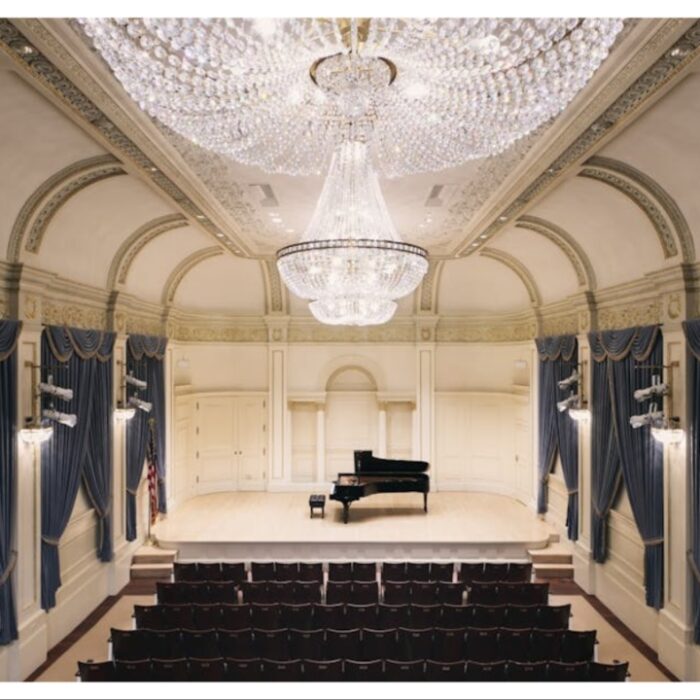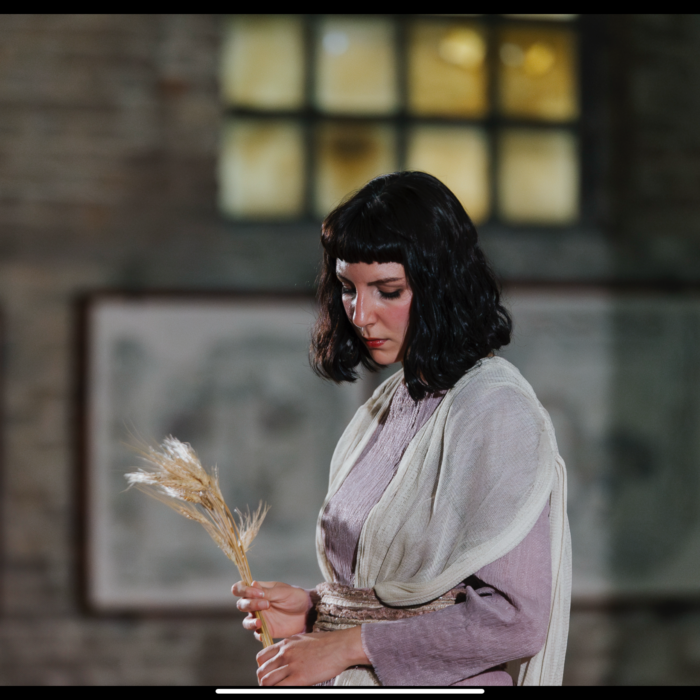
Metropolitan Opera 2018-19 Review: Dialogues des Carmélites
Led By Insightful Yannick Nézet-Séguin & Immersive Isabel Leonard, This Is A True Theatrical Coup
By David SalazarIn 2018-19, the Metropolitan Opera arguably saved the best for last.
After opening the season with seeming inconsistency in terms of overall quality, the company seemed to get into the rhythm of things, producing a solid second half to the season that seemingly got better as we approached the end.
And the company arguably reached the creative apex of its season with the final production of the year – Poulenc’s “Dialogues des Carmélites.” Dark, meditative, slow, intense, violence, and above all, sublime, this opera about the existential experience of a convent’s sisters in the midst of the French Revolution is one of the great masterpieces composed in the 20th century.
The Met’s production by John Dexter is the only version of the work that New York audiences have seen at the legendary theater. And there is a reason for that.

When the curtain rises, the audience is struck by a powerful image – a sea of nuns lying in prone position, their hands outstretched to look like a Christ-like figure. Moreover, they all lay across a cross that dominates the stage from start to finish. Around the cross on the ground is a massive sea of black. The image immediately evokes a plethora of ideas, including the sense of claustrophobia, with the cross an island protecting the nuns from the dark world around them.
The nuns bookend the first section of the opera by returning to this same stance at a later point after welcoming in Madame Lidoine as the new prioress; the entire first section charts the change in leadership, so it is only fitting to emphasize the cyclical nature via the most emblematic image of the first half.
Dexter also has small pieces of set drop from the rafters to create the home of the Marquis de la Force or a gate to separate Blanche from the order of the nuns when she first arrives. It’s a minimalist approach, but is far more effective and evocative than other more complicated techniques one often finds onstage.
The direction of the production allows great freedom for the performers, which was another major reason for the production’s greatest success.
Connecting Two Different Mothers
Let’s start with Karita Mattila as Madame de Croissy, whose performance is one of those iconic moments that will forever be seared onto your memory. It really came down to that second scene where, completely landlocked to a bed, she gave the audience a visceral struggle of someone trying to overcome a fate she knows all too well. The scene sits very low vocally, and while Mattila’s voice seemed to lose focus down there, it suited the moment quite perfectly; you almost felt that her vocal attempts in her lower register matched the Prioress’ increasing loss of energy. As she moved closer and closer to that fateful moment, her singing grew more intense and edgier.
There was increased harshness as she begged Javelinot to let her see the remaining sisters. In the score, Poulenc invokes a “Tres Violent” tempo marking as Madame de Croissy states “Que suis-je à cette moment,” the entire passage littered with sixteen notes and a lot of fortissimo singing. Mattila’s voice took on a disembodied quality, mixing singing and spoken vocalization to truly mesmerizing effect; the battle for survival was amply felt all the more by her sudden jolting around the bed. She seemed to build and build throughout the passage with a continued stream of vocal resources. This was one of the most gripping moments of opera this entire season and it all ended with her body falling over the bed, in prone position. A startling silence ensued, the energy that Mattila had released suddenly sucked out of the space for those two seemingly endless bars.

Contrast Mattila’s violent battle with a more soothing approach by Adrianne Pieczonka as Madame Lidoine. Lidoine’s first scene, “Mes chères filles,” is a rather lengthy monologue with minimal rhythmic variation. For pages, the interpreter of this role is asked to sing rising and falling eighth notes with a few quarters and rests interspersed for cadence. It goes on for pages like this as she talks to the sisters about the potential martyrdom that awaits them. Pieczonka unlocked the beauty of this scene with flowing legato singing. At the risk of losing clarity on some of the consonants, her ability to have each eighth note flow seamlessly was hypnotic and soothing. While some of the higher notes might have had a harsher quality that undercut this otherwise serene and flowing line, it all created a sense of calm and tranquility throughout the experience.
No doubt, this became emblematic of Pieczonka’s interpretation as a whole, for while Mattila’s struggle with death was one of heroic violence, Pieczonka’s Lidoine faced death down with a sense of duty and calm. Every single moment she was onstage, she was gentle and nurturing to the other sisters and as she walked to face the guillotine, she betrayed little fear.
This sharp contrast between the two Prioresses was balanced by the performance of Karen Cargill, who as Mother Marie seemed to shift from a cruder, stricter woman at the start to a more emotionally open. There’s a moment after the death of the Prioress where Blanche is frightened by the corpse and attempts to run off. Marie stops her with fortissimo “Que faites- vous?” which rises to a high B flat at the end of the entire phrase. These utterances were powerful and immediately emphasized the rigidness of Cargill’s Marie; we had seen hints of this in the prior scene with Madame de Croissy, but here she really came off as a force and even a threat to the frightened Blanche. This brief section really brought Cargill into the narrative at full force, though there was a great softening that took place as the story progressed.
Perhaps this was most beautifully explored in her scene with Blanche near the end of the opera where she seeks her out and asks that she return to be with the nuns once more. While Leonard’s Blanche unraveled, her sturdy sound and delicate physical gestures brought about a sense of comfort.
Ultimately, Cargill’s performance, which was explored through arguably the most stable and technically secure singing of the entire night, made Mother Marie the ultimate bridge between the two Prioress’ and the heart of the order.
Diverging Narrative Arcs

Contrast was also played up between the two youngest women of the order – Constance and Blanche de la Force. As Constance, Erin Morley started off the night with sprightly vocalism. Her opening “Encore ces maudites fèves” is a lively passage that brought some comic relief. Dancing about and singing with brilliance, especially on the high Bs and high Cs natural she is tasked with, Morley was pure life and joy. One knew that such optimism couldn’t last, but it was a relief to experience it after the dark opening of the work to this point.
One usually wouldn’t be thrilled to hear a singer start to add some shrillness to her top throughout the course of a performance, but in this case, Morley’s harsher and more agitated sound was revelatory, exposing the increasing fear at the core of Constance. One could feel her early religious ideals caving in around her.
Near the end of the work, she utters her belief that Constance will join the order at their death. In contrast to her first vision during her first scene with Blanche, Morley betrayed a sense of fear throughout this profession; the optimism we saw earlier on seemed more of subdued desperation, as if she were clinging to a hope that she herself was not quite sure of. Her body language was a complete contrast with her opening scene. While her body was open and active during that earlier moment, here she was more withdrawn and far less mobile.
On the other end of the spectrum was Isabel Leonard’s Blanche.
A Study in Fear
Blanche de la Force is often seen as the main character in this work. She evolves from a young girl so full of fear for the impending revolution that she hides herself in a monastery. But she never quite fits in and try as she does, she can’t seem to shake off her fear. She runs away from the order when things get bad, only to eventually find the courage to meet her inevitable fate alongside her sisters.
It’s a demanding role, especially because the other characters that Blanche repeatedly interacts with are far more extroverted in their expressiveness. Blanche demands an actress who can allow a window into Blanche’s more introverted nature.
Earlier this year, Isabel Leonard scored one of her greatest artistic coups as the title role in “Marnie” and one might argue that Blanche was even better. Leonard’s performance was a counterpoint to everything else that seemed to happen around her and it would be impossible to analyze what she brought without first exploring the other interpreter’s own contributions.
The opening scene of the opera was a muted experienced overall. While Jean-François Lapointe’s voice exploded with increased agitation during the crescendoing “Le carrosse, le foule,” it was really the only moment where the opening released any violent energy. The remainder was rather subdued and proper, emphasizing the world of the Marquis and his children. Leonard, while walking around with a grim expression, kept to herself both physically and vocally. Even the scream of fear she gave off-stage seemed rather contained, especially when contrasted with other such visceral expressions later on. In general, her fear felt like an abstraction, though her body language did suggest something pursuing and bothering her.
When she faced off with Constance in their opening scene, Leonard was the vacuum sucking out Morley’s liveliness. Leonard’s sound was darker and weightier, suggesting a sardonic nature at times. But there was an increased agitation in her questioning of Constance and at the close of the scene we really got a taste of Leonard’s emotions coming to the fore, the mezzo-sopranos’ voice climaxing in a harsh but visceral high B-natural on “Je vous defend!”
During Mattila’s death scene, Leonard remained rather submissive and quiet, even if she reacted potently to Mattila’s pain, though her final utterances “La Réverende Mère désirait, aurait désirait” expressed confusion as her voice quieted. She didn’t bury her head and weep, but looked stunned and immobile; she had no idea what to do. In this moment, Leonard’s interpretation started to take flight, and this sense of confused direction for the character became more noticeable in other interactions.
This came to the fore in her confrontation with her brother, played by David Portillo. The tenor displayed a sense of distance in his opening scene with his father, often singing delicately and politely, his back turned from his father and his entire body rather removed. But here, despite being separated by a gate, Portillo got as close to Leonard’s Blanche as the geography permitted. His singing matched this longing, the tenor fully fleshed out in a way that was only hinted in the opening scene. Where the vocalization in that opening was rather gentle and disconnected, here his singing had arching vocal lines and sweeping legato, often climaxed by delicate and beautiful high notes.
Meanwhile, Leonard displayed vocal coldness to her brother, her back often to him in a staging that mirrored his own positioning to his father. But while her sound was rather limited in its color variance, her body language betrayed a wider range of emotions. In one moment she retained the coolness toward his pleading, but would suddenly shift a bit as if ready to face him. She would stop herself and move further away, as if putting distance would help her avoid him better. Eventually, the Chevalier de la Force tires of this treatment and decides to leave, and here Leonard, led by Poulenc’s Molto Agitato marking, really allowed her singing to flourish with newfound desperation. To that point her “Oh! Ne me quittez pas” was her most passionate moment and the two high As that encapsulate the passage became cries of true fear and pain, Leonard building to the latter with an expansive vocal array. It almost felt like we were finally allowed access to Blanche’s deeper emotions and turmoil.
It all came to a boil when she is met by Marie at her old home, now working as a maid. Here Blanche’s emotions imploded as she cried over some spilled food, the voice fraying in a deeply expressive manner. Compare that moment to her cry of fear at the start and you really got a sense of the overall emotional arc of the character. The first was subdued and proper; this one was savage and gritty. One was overseeing a shadow; this one, over making a potentially deadly mistake.
But this proved the lowpoint and after some consolation from Mother Marie, Blanche’s next appearance closes her arc beautifully. As Constance wanes at meeting her death, Blanche appears to comfort her. For the first time all night, we see Blanche smile. I was personally wondering about it the entire night and to finally see her do it was cathartic, even if it was the most subdued of gestures. As she moved further upstage, it might have been increasingly difficult to see, but she retained it all the way through and her singing had a brightness to it that had been missing otherwise.
Leonard’s performance was undeniably her best work of the season and its subtly will likely gain so much more from being seen up close in cinemas on Saturday.
It must be mentioned that the ensembles and choral moments were simply glorious, particularly the different prayers we hear. The famed “Ave Maria” had a pristine quality to it, but the final ensemble, in which the voices diminish one by one were seamless in their transitions.
Musical Shape And Structure Revealed
I have been critical of Yannick Nézet-Séguin this season, particularly for his work in “La Traviata.” But here he really brought his best qualities as a musician and musical director to the fore. It can’t be stated enough just how polished the Met Orchestra is under his baton. Every single note is in its place and the blending of the different colors is sublime. In this score that was most readily apparent and you could both hear the sections on their own and as an overall musical unit.
But what was most impressive was his ability to explore the musical form of the opera with nuance and elegance. The opera opens on a sequence of four eighth notes underscored by an ostinato in the strings. A few moments later we hear an ornamentation that emphasizes Poulenc’s ability to play with form and meld more classical gestures into his modern score. This takes place throughout the night, even the tonal shifts grow more modern in the effect. But back to those first four notes – in their original form they stick with you because of their immediacy and scoring. But they return again and again, transformed; a fate motive if you will. You can easily miss them in their different transformations, but Nézet-Séguin was adept at bringing them to the fore without being heavy-handed. Suddenly the shape and structure of this piece came to the fore in a way that is definitely not as apparent in other interpretations.
Throw in the fact that the conductor managed to find a shifting balance between the work’s violent and graceful nature and it came alive with a sense of competing fates. As the violence of the world became more prevalent, there were harsher attacks, more explosive dynamics, and just a greater sense of darkness. In the context of this production, with its dominant black-white palette, the musical direction was as good as one could ask for. Here’s to hoping that as the music director comes into his own, he delivers even more insightful turns such as this one.
There is one performance of “Dialogues des Carmélites” left and by all accounts, it is almost sold out. Go see it. And if you can’t make it to the theater, go to your local cinema and watch it. And if that show is sold out, then buy tickets for the encores. The Met’s season didn’t get off to the best of starts, but you couldn’t script a more cathartic ending.


